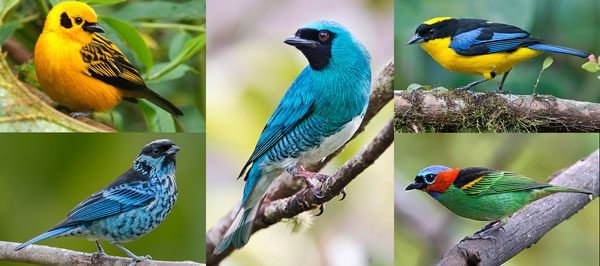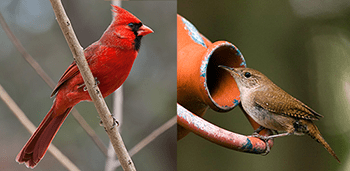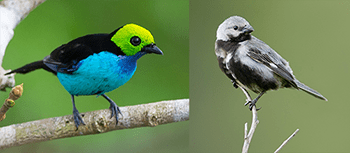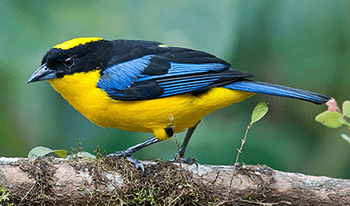Maybe Birds Can Have It All: Dazzling Colors and Pretty Songs, Too
By Hugh Powell June 20, 2014
A study of one of the world’s largest and most colorful bird families has dispelled a long-held notion, first proposed by Charles Darwin, that animals are limited in their options to evolve showiness. The study—the largest of its kind yet attempted—was published today in the Proceedings of the Royal Society B.
The natural world is full of showstoppers—birds with brilliant colors, exaggerated crests and tails, intricate dance routines, or virtuosic singing. But it’s long been thought that these abilities are the result of trade-offs. For a species to excel in one area, it must give up its edge in another. For example, male Northern Cardinals are a dazzling scarlet but sing a fairly simple whistle, whereas the dull brown House Wren sings one of the most complicated songs in nature.
Animals have limited resources, and they have to spend those in order to develop showy plumage or precision singing that help them attract mates and defend territories,” said Nick Mason, the paper’s lead author. “So it seems to make sense that you can’t have both. But our study took a more detailed look and suggests that actually, some species can.” Mason did the research as a master’s student at San Diego State University. He is now a Ph.D. student at the Cornell Lab of Ornithology.
Northern Cardinal vs. House wren
Naturalists have long noticed that bright, showy birds like the Northern Cardinal often sing simple songs, while plainer birds like the House Wren often sing complex songs. Listen:
Northern Cardinal recorded by Gerrit Vyn/Macaulay Library. [Audio description: A loud string of two-parted whistles and series of down-slurred notes.]
House Wren recorded by Geoffrey A. Keller/Macaulay Library. [Audio description: A jumbled mix of nasal-sounding notes, chirps, trills and high-pitched squeaks.]

Mason and his colleagues tested the idea of trade-offs by looking at a very large family of songbirds from Central and South America, the tanagers. This group consists of 371 species—nearly 10 percent of all songbirds. It includes some of the most spectacularly colorful birds in the world (such as the Paradise Tanager) as well as more drab birds (like the Black-bellied Seedeater). The group also includes both accomplished and weak songsters alike.
Tanagers: plumage and song
The study compared plumage and song complexity in the tanager family, which has showy species like the Paradise Tanager and more drab birds like the Black-bellied Seedeater. Compare the two songs:
Paradise Tanager recorded by Curtis Marantz/Macaulay Library. [Audio description: High-pitched chirps and whistles.]
Black-bellied Seedeater recorded by Natxo Areta/Macaulay Library. [Audio description: Songs with series of several mixed sounds like of whistles and trills.]

The research team examined museum specimens of 303 tanager species, using a spectrophotometer to measure nine aspects of plumage coloration, such as brilliance and contrast. They took a similar approach to the birds’ songs, analyzing more than 2,700 recordings to measure 20 song variables including length, bandwidth, and number of syllables. (By the end of the project, Mason had earned the distinction of being the largest-ever single user of the Cornell Lab’s Macaulay Library sound archives.) Finally, the team compared how plumage and song complexity varied at each of the branches along a recently completed evolutionary tree of the tanager family.
“If there were going to be any group of birds at all that would show this trade-off, the tanagers would be a very good candidate, because there’s all this variation in song and plumage complexity,” Mason said, noting that the group’s large size lends confidence to the statistical analysis. “But when we dive into it and do some rigorous statistics, it turns out that there is no overall trend. Tanagers can be drab and plain-sounding, or colorful and musical, or anything in between.”
The Blue-winged Mountain-Tanager: Does This Bird Have it All?
The Blue-winged Mountain-Tanager was ranked #4 in plumage complexity. But it and its close relatives also have complicated songs, contributing to the study’s finding that there is no evolutionary trade-off between plumage and song complexity. Listen to its song:
Blue-winged Mountain-Tanager recorded by Andrew Spencer/Macaulay Library. [Audio description: A song of lots of mixed sounds—sharp whistles, series of up-swinging notes and chirps.]

As a byproduct of the analyses, Mason was able to put together top-10 lists of tanagers with the most colorful plumage and the most complex songs. Those lists help illustrate the overall lack of a trade-off between singing and plumage. For example, a single genus of mountain-tanagers had members on both lists. The Lacrimose Mountain-Tanager ranked #8 among the most complex songs, while the Blue-winged Mountain-Tanager had the fourth most complex plumage of all 303 species examined.
The study puts a significant dent in the idea of evolutionary trade-offs between plumage and song. It’s still possible that trade-offs take place at the level of genus, Mason said, or that they influence species relatively fleetingly as evolutionary pressures appear and disappear. But as a broad effect on an entire family of birds, a voice–plumage trade-off doesn’t seem to exist. One possibility is that the resources needed to develop fancy plumage are different from the ones required for complex songs, freeing tanagers to invest in both forms of showiness simultaneously.
In addition to Mason, the study’s authors include Allison Shultz and Kevin Burns, both of San Diego State University. The research was funded in part by the National Science Foundation and the National Geographic Society.

All About Birds
is a free resource
Available for everyone,
funded by donors like you
American Kestrel by Blair Dudeck / Macaulay Library
